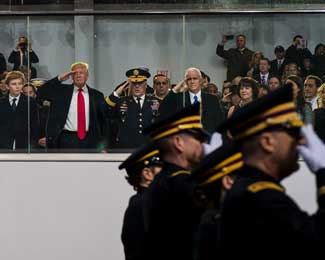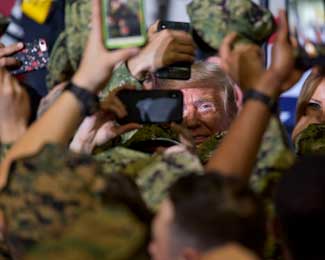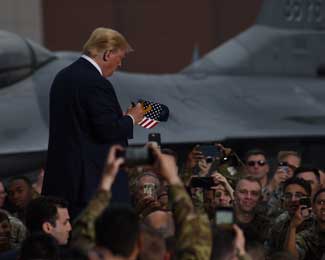Trump Sketches Future of US Military—Hunting Cartels, Quelling Unrest, and Immigrant Detention Camps
Military officials, Donald Trump told a crowd at a rally in Iowa this past October, are “some of the dumbest people I ever met in my life.”
It wasn’t the first time the Republican front-runner and former president offered his opinions on those who have served. During his first presidential campaign, Trump famously belittled John McCain, who was shot down during a bombing mission over Vietnam in 1967, and spent more than five years as a prisoner of war.
“I like people that weren’t captured, OK?” he said. Later, after McCain died, Trump reportedly complained to his aides about half-masted flags. “What the fuck are we doing that for?” he asked. “Guy was a fucking loser.”

President Donald Trump; Gen. Mark Milley, chief of staff of the Army; and Vice President Mike Pence salute a formation of U.S. Army soldiers taking part in the 58th Presidential Inauguration Parade in Washington on Jan. 20, 2017. Photo by Master Sgt. Michel Sauret, courtesy of the U.S. Army Reserve.
As president in 2018, he also allegedly called veterans buried in military cemeteries “losers” and referred to the 1,800 Americans who died at Belleau Wood, the famous 1918 Marine Corps battle, as “suckers.” And in 2020, after he contracted Covid, Trump suggested that Gold Star families he had recently met with were to blame.
At the same time, Trump also clearly relished the pomp and circumstance of the military during his time as president. He understood the value of an institution still highly respected in American society, and its utility as a tool to get things done. At the height of the Black Lives Matter protests in 2020, Trump had Gen. Mark Milley, then the chairman of the Joint Chiefs of Staff, accompany him as he walked across Lafayette Square for a photo op, while local and federal law enforcement dispersed protestors with tear gas, rubber bullets, and flash grenades. Milley quickly apologized, saying he believed he was going to be reviewing National Guard troops at the square.
Trump stood up the Space Force. He threatened military force against North Korea. He sent thousands of active-duty troops to the U.S. border with Mexico, augmenting National Guard units there. He diverted billions of dollars of Pentagon funding to help build his border wall.
He floated other ideas, too—shooting civilian protestors, for instance, which he asked then-Defense Secretary Mark Esper about, according to Esper’s memoir. Reporting from The New Yorker and other outlets has detailed how Esper, Milley, and other officials intervened to prevent the military from being overtly politicized in the run-up to the 2020 election and Jan. 6. In January 2021, all 10 former living defense secretaries wrote a public letter urging the peaceful transfer of power amid Trump’s false insistence that the election was stolen.
Yet Trump has historically enjoyed support from the military community—though that vote is not assured. Before the 2020 election, 235 retired generals and admirals signed a letter in support of Trump’s reelection campaign, claiming that “socialists and Marxists” put the nation at risk. In the spring of 2021, 124 retired flag officers released another letter leveraging their military authority to falsely question the results of the 2020 election.
So what have Trump and his loyalists said about how they might use the military in a second term? The War Horse reviewed campaign and policy videos, speeches by Trump, and other reporting that addresses the question. Here’s what we learned.
1. Use military force against drug cartels.
In a policy video released in December, Trump said that, as president, he would declare drug cartels “foreign terrorist organizations” and order the defense department to use “Special Forces, cyber warfare, and other overt and covert actions to inflict maximum damage on cartel leadership, infrastructure, and operations.”
Last spring, Rolling Stone reported that Trump had asked advisers for military options to “attack Mexico” if he’s reelected. One policy paper from The Center for Renewing America, a think tank staffed by Trump administration veterans, lays out justifications for “waging war” on drug cartels. Esper, the former defense secretary, also revealed that Trump had asked about the possibility of launching missiles into Mexico to target drug labs during his first term.
Trump has suggested he would convince the Mexican government to support such military action—obviously a tough sell.
“Armed foreigners cannot intervene in our territory,” then-President Andrés Manuel López Obrador said after Trump first suggested designating cartels as terrorists, in 2019.
Trump has also proposed using Navy and Coast Guard ships to stop the flow of drugs on the water. In 2020, Trump increased the number of U.S. military ships and aircraft in the Caribbean; his campaign video promises a “full naval embargo” of the cartels.
Christopher Fettweis, a political science professor at Tulane University, says that’s unlikely, and that such actions would essentially stop trade with Mexico.

President Trump poses for photos with U.S. sailors and Marines during a visit aboard the amphibious assault ship USS Wasp (LHD 1) in 2019. Photo by Mass Communication Spc. 3rd Class Benjamin F. Davella III, courtesy of the U.S. Navy.
“You can try to hide fentanyl precursor chemicals in a lot of different ways. Are we going to go through every cargo ship going into Mexican ports? There’s no way.”
Further, certain military actions Trump has suggested might be illegal, and any larger-scale operations run the risk of pulling U.S. military resources into another lengthy quagmire—“then it’s about essentially a guerrilla war against a criminal organization,” Fettweis says.
“If your primary tool is a hammer, everything’s going to look like a nail. But it’s not the case that every problem can be solved through military force.”
2. Rid the military of “Marxism” and “communism.”
It’s no surprise that Trump has promised to reinstate the ban on transgender people serving in the military that he rolled out during his first term. And he has said he would bring back service members removed for failing to adhere to the Covid vaccine mandate “with an apology” and back pay.
Trump and those in his orbit have also been hinting at broader ideological screening in the military. References to Marxism and communism are increasingly used as dog-whistle references to diversity, equity, and inclusion programs, which Trump has repeatedly promised to end throughout the military and the federal government at large.
“We have to get political correctness out of our military,” Trump said at a campaign rally in 2022. “The woke generals should be fired immediately.”
In the Heritage Foundation’s most recent Mandate for Leadership—a blueprint for Republican governance it has published prior to every presidential administration since 1981—the chapter on the military calls for “rigorously review[ing]” all flag officer promotions to see if officers have prioritized things like climate change or “social engineering.”
Award-Winning Journalism in Your Inbox
Military candidates already undergo a battery of screening—medical, mental health, physical fitness, “moral character” assessments. The Pentagon also screens for evidence of gang-related and extremist behavior.

President Trump visits the 10th Mountain Division at Fort Drum, New York, on Aug. 13, 2019. Photo by Sgt. Thomas Scaggs, courtesy of the U.S. Army.
“There’s already ideological screening within the military,” says Rachel VanLandingham, a former military lawyer who teaches national security law at Southwestern Law School. “Congress has told the Department of Defense to, for example, look for gang-related symbols, because we don’t want extremists within the military. But then it becomes, ‘What is the definition of an extremist?’”
Trump would also likely reinstate an executive order implemented during his final weeks in office in 2020. Known as Schedule F, it could reclassify tens of thousands of career civil servants who deal with policy issues throughout the federal government, stripping them of long-standing protections, and making them easier to fire and replace with Trump loyalists. Axios, which reported extensively on the plan in 2022, has said it could affect the intelligence community, civilian defense employees, and the justice and state departments.
Trump said as much in a 2022 rally in South Carolina.
“We will pass critical reforms making every executive branch employee fireable—fireable, by the president of the United States,” he told the crowd there, to cheers.
3. Deploy the military against civilian protestors.
Last year, The Washington Post reported that Trump loyalists were drafting plans to potentially mobilize the military against demonstrators as soon as his first day back in office. The justification would ostensibly come from the Insurrection Act, a law that traces its roots to the earliest days of the republic and allows the president to use the military or federalize the National Guard “whenever the President considers that unlawful obstructions, combinations, or assemblages, or rebellion against the authority of the United States make it impracticable to enforce the laws of the United States.”
“The Insurrection Act essentially gives the president unilateral authority to make those determinations,” says Gregory Foster, who teaches courses in civil-military relations at the National Defense University.
Since its inception more than 230 years ago, U.S. presidents have invoked the Insurrection Act 30 times. The first was George Washington, who used it to suppress the Whiskey Rebellion, a violent protest by grain farmers against the newly imposed “whiskey tax.” Most recently, in 1992, President George H.W. Bush employed the act to call up 400 soldiers and Marines to supplement National Guard units deployed in the aftermath of the 1992 riots in Los Angeles.

President Donald Trump and first lady Melania Trump visit gravesites in Section 34 of Arlington National Cemetery, Arlington, Virginia, May 23, 2019. The year before, Trump reportedly declined to visit a different military cemetery, saying it was “filled with losers.” Photo by Elizabeth Fraser, courtesy of the U.S. Army.
During the 2020 protests over George Floyd’s death, Trump administration officials reportedly drafted a proclamation to invoke the Insurrection Act to use federal troops to clear protestors, but did not use it.
“I think one of the implicit assumptions that we make about sound civil-military relations [is that] it’s predicated on the notion that it involves a commander in chief who acts in good faith as a responsible agent of the state, and employs the military prudently and judiciously in the public interest on matters of necessity,” Foster says.
But there’s nothing in the law that makes any of that assumption a precondition for invoking it.
“He could view anything that causes him discomfort or seems to stand in the way of what he wants to accomplish as a proper basis for employing the military,” Foster says.
4. Use the military to build detention camps and National Guard troops to round up migrants for mass deportations.
Reporting from The New York Times last fall revealed that military troops are integral to immigration plans Trump allies are developing. Troops at the southern border aren’t that unusual—both Republican and Democratic presidents, including Biden, have sent units, as have multiple governors, including some whose states are far from border states. But Rolling Stone has reported that Trump allies are talking about hundreds of thousands of troops.
Military troops—including the National Guard, when mobilized by the president rather than a state governor—are subject to posse comitatus, the statute that largely bars the military from acting in a domestic law enforcement capacity.
“[If] they’re just putting up concertina wire and providing logistical support to fly a helicopter from X to A to B, then that’s fine,” VanLandingham says.
The Stafford Act similarly permits states to request federal troops to assist with disaster relief. Those troops are also subject to posse comitatus. But Trump might not need to call up the Guard himself. When troops are mobilized by a state governor, they can act as law enforcement—like the new Texas Tactical Border Force.
“I think the Guard is attractive because [Trump] can get governors to relinquish guard units to deal with a situation,” Foster says.
5. Deploy the National Guard into American cities struggling with crime and mental illness.
In a 2022 speech at the America First Policy Institute Summit, Trump said he was unwilling to wait for governors to mobilize the National Guard in cities where he sees problems.
“We shouldn’t be doing that anymore,” he told supporters. “When governors refuse to protect their people, we need to bring in what’s necessary anyway. We have to go beyond the governor.”
Such authority would ostensibly come, again, from the Insurrection Act.
Our Journalism Depends on Your Support
“It allows for federalized troops, the Guard or the standing U.S. military to be used for law enforcement purposes within the United States,” VanLandingham says. The only real guardrail, she says, is that those troops would theoretically be required to respect other fundamental rights.

President Trump signs a hat for a service member after speaking to the troops at Osan Air Base, Republic of Korea, June 30, 2019. Photo by Staff Sgt. Sergio A. Gamboa, courtesy of the U.S. Air Force.
“The Insurrection Act does not suspend the rest of the Constitution,” she says.
In his speech at the America First Policy Institute Summit, Trump seemed to push for an expanded definition of law enforcement, lumping homeless and mentally ill people in with criminals. He said the government had a duty to use whatever tools at its disposal to “clean out the mess.”
In a video released on TruthSocial last spring, Trump said, “When I’m back in the White House, we will use every tool, lever, and authority to get the homeless off our streets.” Homeless people, Trump said, would be arrested and relocated to “large parcels of inexpensive land.”
Of course, political candidates say all sorts of things to rile up their base—Trump himself raised plenty of ideas in his first political run that did not come to fruition. On the other hand, many did.
“It deserves public scrutiny,” VanLandingham says of Trump’s comments about the military generally. “If someone tells you that’s what they’re going to do, you should believe them.”
This War Horse feature was reported by Sonner Kehrt, edited by Kelly Kennedy, fact-checked by Jess Rohan, and copy-edited by Mitchell Hansen-Dewar. Abbie Bennett wrote the headlines.





Comments are closed.